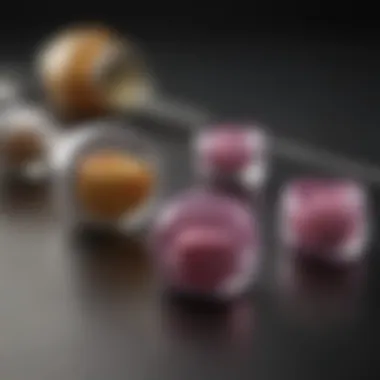Best Pill Crushers for Feeding Tube Use


Overview of the Topic
Definition and Importance
Pill crushers are essential tools designed to break down medications into smaller, more manageable forms. This is particularly significant for individuals using feeding tubes, as many medications are not in formulations that are compatible with such feeding systems. Improper medication administration can lead to ineffective treatment or even harm to the patient. Therefore, understanding the best pill crushers for this specific purpose is crucial for healthcare professionals, caregivers, and patients themselves. The right tools ensure that medications are delivered smoothly and effectively into the digestive system.
Current Trends
In recent years, there has been a noticeable increase in the demand for specialized pill crushers. Factors contributing to this trend include an aging population, rising chronic health issues, and the increased complexity of medication regimens. Brand like Medline and Apex have introduced innovative designs that prioritize user safety and ease of use. Furthermore, many of these products now feature antimicrobial materials to enhance hygiene, an important consideration for patients with compromised immune systems.
Key Techniques and Practices
Step-by-Step Guide
Using a pill crusher involves several steps to ensure the medication is appropriately prepared for feeding. Here are the steps outlined:
- Gather Materials: Collect the necessary tools, including a clean pill crusher and the medication to be crushed.
- Inspect Tablets: Check for any restrictions on crushing certain medications. Some pills are not meant to be crushed due to their formulation.
- Prepare the Pill: Place the pill into the crusher's compartment, ensuring it sits flat for an even crush.
- Crushing: Close the device and apply firm pressure. If using a manual crusher, you may need to twist or push down repeatedly.
- Check Consistency: Open the crusher and inspect the powder. Avoid large chunks, as they can clog feeding tubes.
- Administer: Mix the crushed medication with a suitable liquid before administering through the feeding tube.
Tools and Equipment Needed
The primary tool needed is a reliable pill crusher. Some may prefer electric models, while others find manual ones sufficient. Here are a few essential features to consider:
- Durability: Look for materials that can withstand frequent use.
- Ease of Cleaning: Choose crushers that can be easily cleaned to maintain hygiene.
- Size: Consider the size of the crusher for practical storage and portability.
Challenges and Solutions
Common Obstacles
Crushing pills does present obstacles. The most common issues include:
- Medication Formulation: Some medications are enteric-coated or extended-release, making them unsuitable for crushing.
- Texture Issues: Incomplete crushing can lead to blockages in feeding tubes.
Innovative Solutions
To address these challenges, the following approaches can be beneficial:
- Consult with Pharmacists: Always check if a specific medication can be crushed. They might suggest alternatives that are easier to administer.
- Invest in Quality Products: Use pill crushers designed to handle harder tablets and equipped with features that ensure thorough grinding.
"Choosing the right pill crusher can enhance the quality of medication administration and improve patient outcomes."
This overview captures the foundational aspects of understanding pill crushers and sets the stage for deeper exploration into specific products and their assessment. The next sections will cover detailed tool evaluations and user insights to provide a comprehensive guide.
Preamble to Pill Crushing
Pill crushing is an essential process, particularly for individuals utilizing feeding tubes. It serves to simplify medication administration in cases where swallowing pills is not an option. Understanding the intricacies of this topic ensures that caregivers and healthcare professionals can deliver medications more effectively and safely.
Pill crushing enhances patient compliance by making it easier to ingest medications. For many, especially those with physical limitations, the prospect of swallowing large tablets poses a significant challenge. Therefore, converting these tablets into a manageable form can make a substantial difference in medication adherence and, ultimately, patient health outcomes.
Significance of Pill Crushing
The act of crushing pills is not merely a convenience; it holds considerable significance in the broader context of patient care. In particular, patients with swallowing difficulties or feeding tubes can find traditional medication forms daunting. Pill crushing offers a solution that optimizes the administration of essential medications. Furthermore, it ensures that medicines are absorbed efficiently by the body, leading to better therapeutic results.
Additionally, certain medications can be better absorbed in pulverized form. The surface area increases once a pill is crushed, leading to improved bioavailability. However, it is imperative to understand that not all medications are suitable for crushing. Some formulations may lose efficacy when altered, making it crucial to consult a healthcare professional before proceeding.
Overview of Feeding Tubes


Feeding tubes are medical devices used to provide nutrition and medication directly into the stomach or intestines. They are often a necessity for patients who cannot eat independently due to medical conditions. Tubes can be temporary or long-term, depending on individual needs. This device allows for the administration of a liquid diet, making it essential to understand how medications can be effectively delivered.
In many cases, patients dependent on feeding tubes rely on caregivers for medication administration. This setting creates a need for efficient and uncomplicated methods of delivering pills. Proper knowledge of pill crushing methods ensures that caregivers can provide medications safely and correctly through feeding tubes, minimizing the risk of blockages or other complications.
Challenges in Medication Administration
Medication administration can be a delicate process, especially for individuals with specific needs, such as those using feeding tubes. This topic is critical in this article because it highlights real difficulties faced in ensuring proper medication delivery. Understanding these challenges is the first step towards improving the administration process and ultimately enhancing patient care.
Physical Limitations of Patients
Patients with feeding tubes often face various physical limitations that complicate medication administration. Some individuals may have difficulty swallowing, which is a primary concern. This limitation can arise from medical conditions such as neurological disorders or muscular diseases, where the act of swallowing is impaired.
Moreover, mobility may be compromised for many patients, making it difficult to operate standard pill crushers. These factors necessitate the use of specialized tools designed to facilitate the crushing of pills efficiently. When selecting a pill crusher, it is vital to consider the physical capabilities of the user. An appropriate tool should not only be easy to use but should also require minimal force, catering to these limitations.
"The right tool can significantly lessen the burden of administering medications for patients with feeding tubes, enhancing both comfort and compliance."
Medication Formulation Issues
Medication formulation presents another significant barrier to effective medication administration in patients using feeding tubes. Many medications are not designed to be crushed or altered, which can lead to serious complications. For example, extended-release or enteric-coated medications may lose their effectiveness if they are crushed. This factor makes it crucial to consult with a pharmacist or healthcare provider before proceeding with pill crushing.
Additionally, the physiochemical properties of the medication must be considered. Some medications may have a bitter taste, which can affect acceptance when administered via feeding tubes. Finding ways to mask this taste without compromising the drug’s efficacy is an ongoing challenge.
In summary, the challenges of medication administration for patients with feeding tubes are multi-faceted and complex. Addressing these issues is vital for ensuring that patients receive the right medication in a suitable form. Failure to do so could lead to suboptimal outcomes and further health complications.
Types of Pill Crushers
The selection of a pill crusher can significantly affect the ease of medication administration for patients using feeding tubes. Understanding the different types of pill crushers available helps caregivers and healthcare professionals choose the right option based on specific needs. This section covers three main types: manual, electric, and disposable pill crushers. Each type has its own characteristics, advantages, and potential limitations, making it crucial to understand their distinct features before making a choice.
Manual Pill Crushers
Manual pill crushers require hand-operated force to grind medications into a fine powder. They are often simple devices, consisting of a chamber and a crushing mechanism, such as a lever or a screw cap. One of the main benefits of manual crushers is their affordability. They do not rely on batteries or electricity, making them convenient for use in various settings.
However, the effectiveness of manual crushers may vary. The user’s strength and technique can influence how well the pills are crushed, potentially leading to inconsistent results. Additionally, if too much force is applied, medications can get stuck in the device, creating frustration. It is important to test different manual crushers for ease of operation, as some designs allow for greater leverage than others.
Electric Pill Crushers
Electric pill crushers automate the crushing process, providing a more efficient method for grinding medications. They typically feature a motorized mechanism that crushes pills at the push of a button, resulting in a finer powder compared to manual options. This aspect is particularly valuable for patients requiring precise dosages when using feeding tubes.
Electric devices often come with multiple settings, enabling users to customize the level of crushing according to the medication's requirement. They are generally easier to use for individuals who may struggle with manual strength or dexterity issues. However, potential drawbacks include the need for power sources, and they may have higher initial costs. Regular maintenance and cleaning are also essential to ensure their longevity and hygienic use.
Disposable Pill Crushers
Disposable pill crushers are designed for one-time use, providing a hygienic option for crushing medications. These crushers are often made of lightweight plastic and are very easy to use. Health professionals may prefer them in settings where cross-contamination is a concern, as they offer a fresh device for each use.
While convenient, disposable crushers can be less environmentally friendly due to their single-use nature. They may also lack the durability of manual or electric options, lasting only for a limited number of uses. This makes it essential to purchase them in bulk or as needed while considering the overall cost. Caregivers must assess the balance between convenience and waste when choosing disposable crushers.
Summary: When evaluating pill crushers, it is crucial to consider usage frequency, budget, and patient comfort. Each type of pill crusher focuses on different aspects of medication administration, so choosing the right type can lead to better outcomes for patients with feeding tubes.
Key Features to Consider
When selecting a pill crusher for feeding tubes, certain features stand out as essential. These elements can significantly influence not only the ease of medication administration but also the overall user experience. Understanding these key features will guide caregivers and healthcare professionals in making informed decisions to enhance patient care.
Ease of Use
A primary factor in choosing a pill crusher is its ease of use. For patients and caregivers alike, a user-friendly design simplifies the medication administration process. Manual crushers may require physical strength, which poses a challenge for individuals with limited dexterity. Automatic or electric crushers can alleviate this issue, allowing users to crush pills quickly and effectively without excessive effort.


The mechanism should be intuitive. For example, some designs have ergonomic handles or straightforward push buttons. A product that requires complicated steps may lead to frustration, thus delaying timely medication. The best pill crushers typically include clear instructions, ensuring that anyone can operate them after minimal training.
Additionally, consider how well the product accommodates different pill sizes and formulations. A versatile crusher that handles various types of medications can save time and reduce the need for multiple devices.
Portability and Design
Portability is another critical aspect to assess when choosing a pill crusher. Many caregivers travel between homes or facilities, making lightweight and compact designs advantageous. A convenient size allows the user to carry the device easily, whether they are handling day-to-day tasks or managing emergencies.
The design should not only focus on aesthetics but also functional attributes. A robust construction will withstand regular use, ensuring longevity. Features like a secure lid can prevent spillage during transport, which is vital in maintaining the integrity and hygiene of medications.
Moreover, color coding or other indicators can aid in identifying which medications have been prepared for use. This adds clarity and further streamlines the administration process in a busy environment.
Cleaning and Maintenance
Cleaning and maintenance are integral to the choice of a pill crusher. An effective device should be easy to disassemble and clean. Residue from crushed pills can lead to cross-contamination, potentially affecting patient safety. Therefore, materials that resist staining and are dishwasher safe could be beneficial.
Manufacturers should provide clear guidance on how often to clean the device and which cleaning products are safe to use. This can prevent damage while promoting hygiene. A product's durability often correlates with simple maintenance, reducing long-term costs and ensuring it remains effective for an extended period.
"A well-maintained pill crusher not only ensures effective medication administration but also contributes to patient safety.”
In summary, when selecting a pill crusher for feeding tubes, considering ease of use, portability and design, as well as cleaning and maintenance will provide a more efficient and safe medication administration process. By carefully evaluating these essential features, caregivers and healthcare professionals can better support their patients.
Top Pill Crushers for Feeding Tubes
The effectiveness of medication administration in patients using feeding tubes heavily relies on the quality of the tools utilized, specifically pill crushers. These devices can have a significant impact on the administration process, ensuring medications are adequately prepared for those who cannot ingest them in their original form. The proper choice of pill crusher is vital for several reasons:
- Consistency: A good pill crusher provides uniformity in the crushed medication, minimizing the risk of blockages in feeding tubes.
- Safety: The right device can help to eliminate sharp edges or powdery residues that might affect tube integrity.
- Ease of Use: Many healthcare providers and caregivers appreciate models that are user-friendly, allowing for quick and hassle-free medication preparation.
In this section, we will explore three highly regarded products that have proven their effectiveness in real-world usage. Each product will be evaluated in terms of features, benefits, and overall suitability for feeding tube applications. The following products stand out in terms of quality, ease of use, and compliance with safety standards.
User Reviews and Testimonials
User reviews and testimonials hold a significant place in the landscape of medical devices and tools. For something as specialized as pill crushers for feeding tubes, these narratives provide insight that professional clinical data may not cover comprehensively. They illuminate real-life experiences, highlighting what to expect from various products in terms of functionality, usability, and effectiveness.
Reviews can illustrate both the benefits and drawbacks of a product, helping potential users make informed choices. Patients and caregivers frequently share their personal experiences regarding the efficiency of the crushers. This can reflect how well these products perform in actual daily scenarios, thus guiding others who face similar needs.
Furthermore, understanding user feedback allows manufacturers to adapt and improve their designs. They can prioritize features that users find valuable and address concerns raised. This mutual exchange of information between users and producers can ultimately enhance product quality.
“Knowing how others have fared with a particular pill crusher can save time and ensure a smoother experience.”
Patient Experiences
Patient experiences are a vital aspect to consider when assessing pill crushers. These testimonies often encompass a range of factors: ease of use, effectiveness in achieving the desired powder consistency, and the overall impact on medication adherence. Patients may recount their frustrations when using less efficient models or the relief they felt when they found a crusher that worked seamlessly with their feeding tubes.
Additionally, patients might comment on the physical strain involved in using the products. For those facing health challenges, a comfortable grip and simple mechanics can greatly influence their enthusiasm towards medication intake. Feedback about how easy it is to clean the device also emerges frequently, as hygiene is paramount in medical settings. Collecting these experiences facilitates a deeper understanding of the practical implications of each product on those who rely on them.
Caregiver Feedback
Caregiver feedback complements patient testimonials by providing an external perspective on the usability and practicality of pill crushers. Caregivers often work directly with patients and have firsthand knowledge of the day-to-day challenges they face. Their insights can reveal how the tools adapt to various patient needs, whether they are elderly, have disabilities, or face cognitive challenges.
Many caregivers emphasize the role that user-friendliness plays. A device that is intuitive and requires little training can significantly reduce stress during medication administration.
Caregivers often mention the importance of efficiency—how quickly and effectively the pill crusher can convert solid medications into a suitable form for feeding tubes. Moreover, they might share tips or tricks they developed to make the process smoother. In doing so, they provide additional depth to the narrative about how well a product serves its primary function.
Through both patient and caregiver insights, the overall user experience can be evaluated more holistically. This collective feedback not only aids prospective buyers but also serves as a catalyst for ongoing improvement and innovation in product development.


Safety Considerations
When dealing with medication administration for individuals using feeding tubes, safety is paramount. The risks associated with improper crushing techniques can lead to severe health consequences, such as inconsistent medication dosages or even medication interaction issues. Thus, addressing safety considerations becomes essential in ensuring both the efficacy and safety of medication delivery.
Maintaining safety not only protects the patient but also reassures caregivers and healthcare professionals. It is critical to prioritize best practices when using pill crushers. Ensuring the equipment used is suitable and hygienic contributes to a safer administration process.
Improper crushing methods can lead to crumbly particles or uneven dosage. Such results can significantly alter how the patient receives the medication. Furthermore, this affects how quickly the medicine takes effect. Therefore, understanding proper techniques is essential for achieving the desired therapeutic outcomes.
Proper Crushing Techniques
Efficient crushing of pills is vital when preparing medications for feeding tubes. The method used directly impacts the quality of the crushed medication and its subsequent absorption. First, it is important to check for any specific instructions from healthcare providers or pharmacists regarding the medication itself. Some medications may not be suitable for crushing at all.
Always consult a pharmacy or healthcare professional when uncertain about crushing.
When employing a pill crusher, follow these steps for proper crushing techniques:
- Select the right crusher: Ensure that the device can handle the type of pill. For larger pills, an electric crusher may be needed.
- Use the correct pressure: Apply gentle yet firm pressure when crushing to achieve a fine powder. Avoid excessive force that could splatter the contents.
- Transfer with care: After crushing, use a spatula or similar tool to transfer the powder into a container suitable for the feeding tube. This reduces the risk of losing medication.
- Check for clumps: Ensure there are no clumps in the powder that may obstruct the feeding tube.
Adhering to these techniques will improve safety and ensure that proper doses are administered efficiently.
Medication Compatibility
The compatibility of medications when crushed is another crucial aspect of safety. Not all medications can be safely crushed for feeding tube administration. Some formulations, such as enteric-coated tablets, are designed to dissolve in specific areas of the gastrointestinal tract. Crushing these pills can destroy their effectiveness and potentially cause harm.
To ensure medication compatibility, consider the following:
- Consult with a pharmacist: They can provide insights into which medications can be crushed and which cannot.
- Refer to medication guides: Many pharmaceutical companies will provide information on the appropriate handling of their products.
- Monitor for adverse reactions: After administering crushed medications, observe the patient for any unexpected side effects. This could signal a compatibility issue.
In summary, addressing safety considerations when using pill crushers ensures accurate medication administration. Understanding proper crushing techniques and recognizing medication compatibility are integral to a high-quality care process. This diligence can prevent complications and optimize treatment outcomes for patients relying on feeding tubes.
Alternatives to Pill Crushing
When medication administration is critical, finding suitable methods that avoid the need for crushing pills can be beneficial. Alternatives to pill crushing not only reduce complexities but also prevent potential complications that arise from improper medication preparation. Understanding these alternatives helps caregivers and patients explore safer routes for medication, especially for those relying on feeding tubes.
Liquid Medications
Liquid formulations represent a significant advancement in medication administration. They eliminate the need for crushing altogether. Healthcare professionals often prefer liquid medications for patients who have difficulty swallowing pills or those requiring precise dosing. Benefits of liquid medications include:
- Ease of Administration: Liquid medications can be administered more smoothly through feeding tubes.
- Immediate Absorption: Liquids tend to be absorbed quickly by the body, often leading to quicker therapeutic effects.
- Flavoring Options: Many liquid medications can be flavored, making them more palatable for patients.
However, there are considerations when using liquids. Not all medications are available in liquid form, which may limit options. Additionally, ensuring compatibility with feeding tubes becomes crucial to avoid clogs or residuals.
Compounded Medications
Compounding is another valuable alternative, especially in situations where specific formulations are not commercially available. Pharmacists can create custom medications tailored to individual needs, enhancing treatment efficacy. Some points of interest regarding compounded medications include:
- Custom Formulations: Medication can be tailored to a patient’s specific dosage and delivery method, which is ideal for those on a feeding tube.
- Variety of Dosage Forms: Compounding can result in liquids, gels, or even dissolvable forms that accommodate different patient requirements.
- Quality Control: Reputable compounding pharmacies adhere to strict guidelines, ensuring high-quality products.
Still, compounded medications necessitate thorough discussions with pharmacists to confirm their suitability and safety for each particular case. This proactive approach can lead to improved patient outcomes, ensuring that they receive precisely what they need for their treatment.
End
The conclusion serves a pivotal role in summarizing the key concepts discussed throughout the article about pill crushing for individuals using feeding tubes. Understanding the significance of using the appropriate pill crushers is beneficial for patients, caregivers, and healthcare professionals. It not only simplifies the medication administration process but also enhances overall compliance with treatment plans. Effective use of pill crushers can prevent complications that arise from improper medication intake.
Summary of Findings
The examination of various tools and techniques for pill crushing reveals several essential aspects. Among the highlighted findings are the advantages of both manual and electric pill crushers. Manual crushers are generally cost-effective and straightforward, while electric ones save time and require less physical effort. Moreover, the review of specific products show that features such as ease of cleaning, ergonomic design, and durability prove critical for users. Overall, the integration of these tools into everyday practices can lead to improved medication adherence, ultimately influencing patient outcomes positively.
Future of Pill Crushers
Looking ahead, the future of pill crushers shows potential for innovation and improvement. As technology advances, we may see more ergonomically designed devices that require less force, ideal for patients with limited hand strength. Furthermore, research into medication compatibility continues to evolve. New formulations might emerge that are more amenable to crushing without compromising efficacy. The market will likely expand as the demand for specialized tools increases, driven by an aging population and rising numbers of patients utilizing feeding tubes. As we move forward, it will be essential to prioritize both safety and convenience in these devices to ensure optimal medication delivery.



